
Superregnum: Eukaryota
Cladus: Unikonta
Cladus: Opisthokonta
Cladus: Holozoa
Regnum: Animalia
Subregnum: Eumetazoa
Cladus: Bilateria
Cladus: Nephrozoa
Superphylum: Deuterostomia
Phylum: Chordata
Subphylum: Vertebrata
Infraphylum: Gnathostomata
Megaclassis: Osteichthyes
Cladus: Sarcopterygii
Cladus: Rhipidistia
Cladus: Tetrapodomorpha
Cladus: Eotetrapodiformes
Cladus: Elpistostegalia
Superclassis: Tetrapoda
Cladus: Reptiliomorpha
Cladus: Amniota
Cladus: Synapsida
Cladus: Eupelycosauria
Cladus: Sphenacodontia
Cladus: Sphenacodontoidea
Cladus: Therapsida
Cladus: Theriodontia
Subordo: Cynodontia
Infraordo: Eucynodontia
Cladus: Probainognathia
Cladus: Prozostrodontia
Cladus: Mammaliaformes
Classis: Mammalia
Subclassis: Trechnotheria
Infraclassis: Zatheria
Supercohors: Theria
Cohort: Metatheria
Cohors: Marsupialia
Cladus: Australidelphia
Cladus: Eomarsupialia
Ordo: Diprotodontia
Subordo: Macropodiformes
Familia: Macropodidae
Subfamilia: Macropodinae
Genus: Dendrolagus
Species: Dendrolagus ursinus
Name
Dendrolagus ursinus (Temminck, 1836)
Type locality: Indonesia, Irian Jaya, Fakfak Div., Lobo Dist., near Triton Bay, Mt. Lamantsjieri
Synonyms
Dendrolagus ursinus Müller, 1840
Hypsiprymnus ursinus Temminck, 1836
References
Dendrolagus ursinus in Mammal Species of the World.
Wilson, Don E. & Reeder, DeeAnn M. (Editors) 2005. Mammal Species of the World – A Taxonomic and Geographic Reference. Third edition. ISBN 0-8018-8221-4.
Discours preliminaire destine a servir d'introduction al faune du Japon, p. 6 (footnote 2).
Wilson, D.E. & Reeder, D.M. (eds.) 2005. Mammal Species of the World: a taxonomic and geographic reference. 3rd edition. The Johns Hopkins University Press: Baltimore. 2 volumes. 2142 pp. ISBN 978-0-8018-8221-0. Reference page.
Vernacular names
English: Ursine Tree-kangaroo
magyar: Medve kúszókenguru
Bahasa Indonesia: Kanguru pohon nemena
日本語: クロキノボリカンガルー
The ursine tree-kangaroo (Dendrolagus ursinus) is a long-tailed, furry, bear-like mammal found only in tropical forests on the island of New Guinea (in Indonesia). Slightly larger than a cat, it lives alone in trees and is active at night to feed on leaves and fruit. It belongs to the macropod family (Macropodidae) with kangaroos, and carries its young in a pouch like other marsupials. It has a small range in northwestern New Guinea and is threatened by habitat loss and hunting. Other common names for this species include the black tree-kangaroo, the Vogelkop tree-kangaroo and the white-throated tree-kangaroo.[2]
Description
This tree-kangaroo grows to a head-and-body length of 50 to 82 cm (20 to 32 in) with a tail of 40 to 94 cm (16 to 37 in), and a weight of up to 8 kg (18 lb). The upper parts are glossy black while the underparts are fawn. There is a whitish collar and throat, and the face is brown with white or red cheeks. The ears are distinctive, being long and tufted. The long fur is whorled on the shoulders, a pattern which is thought to help carry excess rainwater away from the head. Compared to terrestrial kangaroos, the limbs are short, with broad feet, well-roughened soles and curled claws for climbing. The tail is long and tipped with white and is used as a counterbalance.[4]
Distribution and habitat
Endemic to the island of New Guinea, the species is present on the Vogelkop Peninsula in the far northwest of the island and possibly also the Fakfak Peninsula in West Papua. It occurs in tropical forests at altitudes between 1,000 and 2,500 m (3,300 and 8,200 ft).[2]
Biology
The ursine tree-kangaroo is nocturnal, solitary and lives mainly in trees, though it can descend to the ground where its gait is bipedal, hopping rather clumsily on its hind legs. It is much more agile among the branches of trees, where it feeds on fruit and leaves. Breeding is thought to take place at any time of year. Being a marsupial, a tiny neonate is born about thirty days after conception, and wriggles through the fur of the mother's abdomen to the pouch. Here it attaches to a nipple and develops for about three hundred days.[4]
Status
D. ursinus has a very limited range and is declining in numbers; the population is thought to have diminished by at least 30% within the last three generations (thirty years). The two main threats it faces are habitat destruction as forests are cleared to provide farming land, and hunting by indigenous peoples for food.[2] Historically, it used to be present in lowland forests, but now it only occurs in mountain forests. The International Union for Conservation of Nature has assessed its conservation status as being "vulnerable".[2]
References
Groves, C. P. (2005). "Order Diprotodontia". In Wilson, D. E.; Reeder, D. M (eds.). Mammal Species of the World: A Taxonomic and Geographic Reference (3rd ed.). Johns Hopkins University Press. p. 61. ISBN 978-0-8018-8221-0. OCLC 62265494.
Leary, T.; Seri, L.; Wright, D.; Hamilton, S.; Helgen, K.; Singadan, R.; Menzies, J.; Allison, A.; James, R.; Dickman, C.; Aplin, K.; Salas, L.; Flannery, T.; Bonaccorso, F. (2016). "Dendrolagus ursinus". IUCN Red List of Threatened Species. 2016: e.T6434A21956516. doi:10.2305/IUCN.UK.2016-2.RLTS.T6434A21956516.en. Retrieved 14 November 2021.
"Appendices | CITES". cites.org. Retrieved 2022-01-14.
"Black tree kangaroo (Dendrolagus ursinus)". ARKive. Archived from the original on 2018-04-03. Retrieved 2 April 2018.
Retrieved from "http://en.wikipedia.org/"
All text is available under the terms of the GNU Free Documentation License

